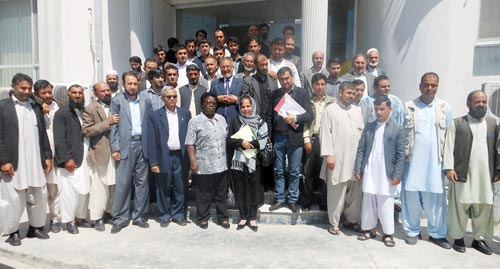By Rajiv Sharma/CIMMYT
Wheat has been receiving a lot of attention ever since new races of destructive fungi emerged, threatening the world’s second most important food crop. The onslaught of stem rust race Ug99 taught researchers and farmers how to use fungicides to control wheat rusts; meanwhile, new races of yellow rust continue to appear, keeping researchers on their toes to offer usable, economical solutions to farmers.
Afghanistan grows wheat on about 2.5 million hectares and has about 20 wheat varieties in its seed chain. Most of them are rust-resistant, but varieties keep losing resistance, while new varieties are added to the seed chain. Since it is not possible to take a newly susceptible variety out of cultivation and out of the seed chain immediately, an integrated rust management strategy must be in place to protect farmers’ interests.
To help develop such a strategy, CIMMYT-Afghanistan joined the country’s Ministry of Agriculture, Irrigation and Livestock (MAIL), the Afghan government and the Agricultural Research Institute of Afghanistan (ARIA) to host a two-day training on “Wheat Rust Management” at the MAIL campus on 6-7 May. The training was conducted by Dr. Ruth Wanyera, principal scientist from the Kenya Agricultural Research Institute, and attended by 47 experts from ARIA, MAIL, the Japan International Cooperation Agency (JICA), the Agriculture Input Project (AIP) of the World Bank, the International Center for Agricultural Research in the Dry Areas (ICARDA), Kabul University and the Australian Centre for International Agricultural Research (ACIAR).

Hashim Azmatyar, acting director of ARIA, stressed that chemical control of rusts is sometimes necessary in cases where virulent races suddenly appear. Dr. Rajiv Sharma, CIMMYT country representative for Afghanistan, exhorted MAIL officials to take urgent steps to remove susceptible varieties from Afghanistan’s seed chain.
The training also covered an introduction to rusts and their scoring, integrated rust management and the evolution of new races. Wanyera delivered a special lecture on how Kenya and the region collaborated with CIMMYT and responded to the Ug99 threat to safeguard the interests of affected farmers. She discussed at length the use of fungicides in managing rusts and shared the African experience on how chemicals offered an economically feasible solution when genetic resistance was not available.
 Capacity development
Capacity development